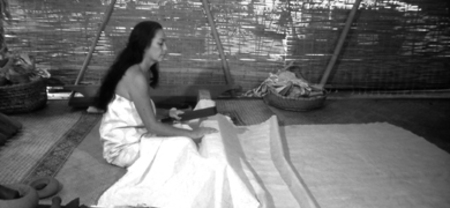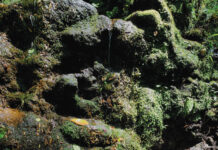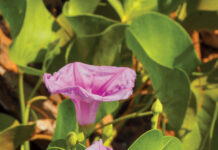Story by Rita Goldman
 At the Hilton Hawaiian Village in Waikiki, there’s a sculpture of three native women at work beside a running stream. Their beauty is Polynesian rather than Western, graceful, composed and strong.
At the Hilton Hawaiian Village in Waikiki, there’s a sculpture of three native women at work beside a running stream. Their beauty is Polynesian rather than Western, graceful, composed and strong.
Nearby, a plaque recounts this legend: Long ago, a Hawaiian man named Maikoha told his daughters that when he died, they were to bury him beside a stream and watch for a sapling that would grow from his grave. When the tree reached the height of a warrior chief, they were to cut it down, strip its bark, and clean and soak the bark in water. They were then to beat the bark to soften its fibers, bleach it in the sun, dye and decorate it, and give it a finish that would keep the colors bright. The result would be a cloth fine enough for even the highest chief.
Maikoha’s daughters did all that their father asked. Lauhuki proved to excel at preparing the bark cloth, La‘ahana at creating the dyes, inks, and designs that gave it its beauty. Hawaiians came to venerate the sisters as ‘aumakua—deities of the intricate art of kapa making.
In the sculpture, the two standing women are the mythic sisters Lauhuki and La‘ahana. The seated figure depicts a real-life, contemporary Hawaiian who has become perhaps as legendary: Puanani Kanemura Van Dorpe, the woman who has made it her life’s mission to resurrect this ancient art.
Throughout Polynesia, and across millennia, traditional cultures have created cloth from bark. The Fijians call it masi, the Tahitians tapa. But in all the Pacific Islands, no people so elevated the art as did the Hawaiians, who named their bark cloth kapa. Europeans, exploring the Pacific in the 1700s, were captivated by the quality of Hawaiian cloth. Captain James Cook himself extolled kapa’s “superiority” and “high degree of integrity.”
“Hawaiians . . . achieved the highest form of this medium,” writes Louise Allrich in FiberArts magazine. “The process . . . is far more complicated than any other bark cloth and the result is a fine, transparent, strong, complex, and soft fabric.”
That laborious process occupied much of the Hawaiian woman’s day. Her handiwork wrapped newborn babes in comfort, clothed children and adults in exquisite patterns and colors, provided layers of warmth to sleep beneath, and shrouded the departed at life’s end. Kapa was also used as payment for taxes, and served as tribute to gods and ali‘i. Yet all that knowledge, all the skills honed over generations, disappeared within a century of the arrival of Western man.






i feel we have a lot to appreciate the continuance of a knowledge almost lost from the bottom of my heart thanks to all